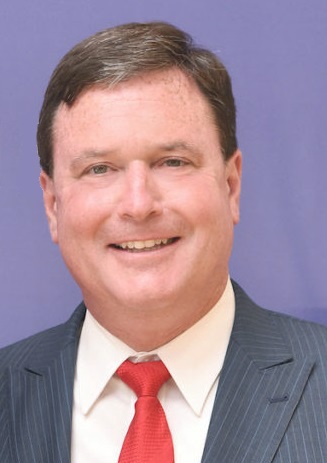
A decade ago, the Indiana Chamber of Commerce commissioned a study on the state’s water supply to provide an account of the resource so vital for everyday life and economic development. Now, through the Indiana Chamber Foundation, the organization has released its follow-up research, “Water Policy and Planning: A 10-Year Update.”
This new report is intended to help set the stage for an integrated water management plan for the state, a key infrastructure and energy priority in the Indiana Chamber’s Indiana Prosperity 2035 visioning plan.
Like the first effort, this study was prepared by INTERA Incorporated, which has a location in Bloomington.
“Today, we have more observations of water levels and more information about flows (than in 2014),” says Jack Wittman, project leader and vice president and principal water resource hydrologist for INTERA. “We have a framework for planning that we’ve simply never had before.”
That’s exactly what the Indiana Chamber was seeking to accomplish, remarks its president and CEO Vanessa Green Sinders.
“Water is such a critical resource for all Hoosiers and it’s imperative to assess current levels as well as help legislators and planners put Indiana in a strong position for the future. We’re grateful for the contributions of all involved in this important study, which we hope can help inform next steps for local and state officials.”
General findings in the new report reveal water in the state is plentiful, but not evenly distributed. Distinctions abound based on geography. For instance, north of the Wabash River, every community, manufacturer and irrigator reportedly has access to their own local groundwater or stream.
In central Indiana, however, water must be well-managed to meet demand as it contains a diversity of sources that include reservoirs, rivers and well fields. And in southern Indiana, “regional water systems have long been the foundation of growth and economic development,” according to the report, relying since the 1960s on sources that include Patoka Lake, Monroe Lake and Brookville Reservoir.
One finding is that while total withdrawals for industrial use are declining overall, capacity may be added regionally as opportunities open for new development.
To avoid conflict, study authors assert, new facilities need to have access to adequate cooling and process water as well as guidance for planning new wastewater returns. In previous decades, industrial water use steadily declined and the use of surface water correspondingly dropped.
The summary continues: “New developments could reverse this trend, so the state needs to consider these plans carefully as the availability within any basin is determined. Where local supplies are unable to satisfy demands for process water, proposals for inter-basin transfers need to be developed with some basic guidance and direction from the state.”
The report also relays that groundwater withdrawal has increased more rapidly than surface water diversions since the 2014 study. The aquifers of the state are becoming increasingly important as a means of satisfying seasonal demands while controlling costs of treatment and conveyance.
Overall, Indiana has enough water for existing proposals and demand, thus putting the state in a much stronger position than, say, its arid western counterparts. Yet the focus turns toward the future.
“What we have to do is think about how future demand might be distributed and how that looks, whether it’s a matter of organic growth from cities or whether we’re actually building mega developments in particular areas,” Wittman offers. “In either case, we have to understand what the effects of high demand for water might be in different basins.”
Using the water study findings to craft meaningful legislation and processes will be the next phase of work. State and federal action will undoubtedly be key, but governments closer to the sources also should play a role.
“Local governments need to be more involved in the process,” Wittman suggests. “There are experiences that counties have now with being more directly involved in the question of water. That needs to be brought to the table and considered.”
Other recommendations include further emphasis on planning; continued coordination by the Indiana Finance Authority; sustainable funding; establishing criteria for setting environmental flows and a framework for data monitoring; developing guidance for regional plans; and cultivating a living state water plan (to build on regional plans).
For the Indiana Chamber, the study release is phase one. “Between now and the start of the legislative session, our organization will be meeting with key lawmakers to share the research and work collaboratively to help shape policy in 2025,” notes Sinders. “We also will be reaching out to local chambers and government officials across the state to highlight these findings and talk about what this means in their communities and how we can partner on enhanced resource planning.”
The research project also included consultations with the Indiana Chamber Water Resources Advisory Committee, consisting of representatives from water utilities, drinking water professional organizations, consultants, relevant state agencies, agriculture, aggregate operations and environmentalists.
Investors in the water study are: ACEC Indiana; AES Indiana; Aqua Indiana; Citizens Energy Group; Ginovus; Indiana American Water; Indiana Farm Bureau; Indiana Mineral Aggregates; Indiana Pork Producers; Indiana Section, American Water Works Association; Indiana Soybean Alliance/Indiana Corn Marketing Council; M.E. Simpson Company, Inc.; National Association of Water Companies, Indiana Chapter; and The Nature Conservancy.
View the full Indiana Chamber Foundation study at www.indianachamber.com/water.

As we wrap up our series “When the Smoke Clears,” our four-part video series highlighting the need to tackle mental health issues of first responders, this latest episode talks about what to look for in yourself and your teammates that might indicate some help is needed. Anger, isolation and excess emotion all can appear when a mental crisis begins to take hold, and this episode provides some examples of “red flags” that can appear before a crisis spirals out of control.
Life in the firehouse is comprised of a very tight-knit community, and routines are typical for all the men and women who are on the job. It could be changes to those patterns that are clear indicators that trouble is brewing, and some conversations may need to happen. If a person begins to remove himself/herself from group settings (firehouse dinners, meetings, etc.), that could lead to riskier behavior down the road. Leaders should look for responders yelling at their teammates more than usual or appearing sad or tired all the time. To be a good teammate, being a good observer is key. Pay attention to the well-being of the people next to you, and they should be paying close attention to your overall health as well.
“When the Smoke Clears” just scratches the surface of the complex environment of mental stress in the public safety field. However, our sincere hope is we can eliminate these barriers and talk openly about a real problem facing first responders today. The brotherhood and family atmosphere of the fire/EMS field offer so many advantages, and it takes this strong support system to help one overcome a mental crisis that develops from the experiences we see and feel through the job. We need healthy firefighters and medics, and that includes being a mentally healthy person. It’s your job and your commitment to be the best you can be, for yourself, your family and your community.
If you have ideas on other topics to cover in a future episode of “When the Smoke Clears,” please reach out to our Public Affairs office via
You can watch all four episodes of the series on the IDHS YouTube channel or online on the IDHS website.


Indiana Attorney General Todd Rokita issued the following statement:
"We sent a blunt message to Gary officials that they needed to follow the law. As a result, the Gary Common Council officially voted to repeal, in its entirety, its unlawful immigration ordinance.
This is a win for law-abiding Hoosiers and legal immigrants who are the ones negatively impacted by the flood of illegal aliens pouring across our southern border. We need to stand for apprehending criminals – NOT providing them with safe harbor.
With the West Lafayette Police Department, the City of East Chicago, and now Gary officials all rescinding illegal 'sanctuary city' policies, we will continue to focus our efforts on ensuring the Monroe County Sheriff's Department does the same."

Sometimes a hidden talent is discovered on America’s Got Talent—so was the case of Richard Goodall.
Goodall, 55 years old, has been a janitor in the Vigo County School Corporation in Terre Haute. He would sing as he worked. He has been a janitor for 23 years.
The middle school students noticed his talent and greatly encouraged him to tryout on AGT. The first time he tried out in 2009 in Chicago, he didn’t get past the first audition. He would wait some 15 years before trying again, and this time with different results.
He made it to the stage of AGT in front of the Howie Mandel, Heidi Klum, Sofia Vergara and the sometime hard judge Simon Cowell.
Nervously he took the stage and introduced himself. After a pause to collect his composure, he began to sing. He sang a really appropriate song, “Don’t Stop Believing,” a song made popular by Journey in 2005.
It wasn’t long before the audience was standing, clapping and dancing to this song.
The judges were taken away with him. At that point he got the total approve of the judges and the roaring applause of the audience.
This greatly humbled the 55-year-old janitor into tears, but the great finale of this performance was yet to come.
Heidi Klum so taken by his performance hit the Golden button, showering the stage with golden graffiti.
She said, “Richard, Richard, Richard! You are living proof that we should never ever stop dreaming, believing, and singing! I cannot wait for America to fall in love with you like I have. It’s an honor to hit my Golden Buzzer for you.”
The Golden Buzzer sends the contestant directly to the Live rounds.
This year there are four stages Audition, Live Quarterfinals, Live Semifinals, and a two-week Finale event.
Howie Mandel said, “You just cleaned up.” Cowell chimed in with “You are my hero.” Of course, he made it to the Live Semi Finals where he sings “How am I supposed to live without you.” originally performed by Michael Bolton.
Goodall said he started singing along with his Radio Shack stereo. He is also in a band called “ ManOpause.”
Tragically his wife Patty died of cancer three year ago.
He is presently engaged to Angela Vanoven. Having missed the first audition, she was in the audience for the Live Semi Finals.
Richard said this was not on his radar and he never had been on a plane before. At a local send-off at the Vigo County Fairgrounds, country music star Walker Hayes gave Goodall a brand-new Buick. Mullen’s Dressing had their own gift for Goodall—a lifetime supply of dressing.
Watch AGT cheer this Hoosier on. Download the America’s Got Talent App and vote to send him through the Live Shows to the Finale.

Richard Goodall

Goodall overwhelmed by confetti after receiving a "Golden Buzzer."

Goodall with his fiancee Angela Vanoven.
- Indiana Home Sales Rebound In July As Buyers Welcome Falling Mortgage Rates, Rising Inventory And A Lower Statewide Sale Price
- $3.7 Million Funding Available for Recycling and Waste Diversion Projects in Central Indiana
- Lt. Gov. Crouch, Indiana Mental Health Roundtable to host Mental Health Matters Day at the Indiana State Fair
- Indiana Law Enforcement Teaming Up To Reduce Impaired Driving
SalemLeader.com
Leader Publishing Company of Salem, Inc.
P.O. Box 506
117-119 East Walnut Street
Salem, Indiana. 47167
Phone: 812-883-3281 | Fax: 812-883-4446
Business Hours:
Mondays through Fridays, 9:00am - 5:00pm
News:
news@salemleader.com
Office:
office@salemleader.com
Publisher:
publisher@salemleader.com
Business
- More Business News
- Go To Guide
- Business Directory
- Auctions
Education
- More Education News
Opinion
- Editorials
- Letters to the Editor
- Columns
- Unsung Heroes
- Days Gone By
- In the Garden
- Guest Columns
- Reader's Poll
- Salem Leader Forum
- Questions and Answers
Church
- Bible Aerobics
- Church News
- Church Directory












